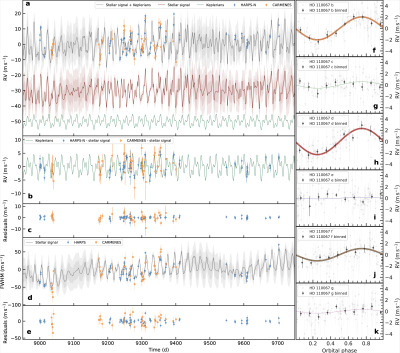HARPSN@TNG provides key data to unlock the rare six-planets star system HD110067
An international collaboration of scientists has discovered a key new extra-solar planetary system of six transiting planets orbiting the star HD110067 in a harmonic rhythm. This rare finding enabled the team to determine the planetary orbits and to offer deep insights into planet formation.
Thanks to a collaboration between the NASA’s satellite TESS, the CHEOPS mission (a joint mission by ESA and Switzerland) and different ground-based telescopes, including the Telescopio Nazionale Galileo, an international team discovered that the six planets associated to the planetary system HD110067 orbit their host star in perfect harmony. HD110067 is a bright K0-type star in the constellation of Coma Berenices with a mass and radius of approximately 80 percent those of the Sun and a temperature ~ 500 K colder than the temperature of the Sun. This star hosts a truly strange family of six planets with sizes ranging between the Earth and Neptune (sub-Neptune planets), and orbit their host star in resonance or in a harmonic rhythm.
In particular, thanks to observations taken with the high-resolution spectrographs HARPS-N (installed at the Telescopio Nazionale Galileo) and CARMENES (at Calar Alto Observatory), the team collected a set of high-precision radial velocities of the star that allowed to confirm the detection of the planet f, to estimate the masses of three planets (b, d, and f), and to place upper limits on the masses of the remaining ones.
The study of multi-planetary systems offers an opportunity to investigate the outcomes of planet formation and evolution while controlling the initial conditions and environment. Those in resonance (where their orbital periods have a ratio of small integers) are particularly valuable because they imply a system architecture practically unchanged since its birth. In particular, such reliable stability means that the planets likely have been performing this same rhythmic dance since the system formed as long as five billion years ago. And that, in turn, could say something important about how this system formed.
In the case of HD110067, a dynamical study of the innermost planet triplet allowed to estimate the orbits of the rest of the planets in such a way that the planet closest to the star completes three orbits for every two of the next planet out – called a 3/2 resonance – a pattern that is repeated among the four closest planets. The result of this “resonant chain” is that the closest planet, with an orbital period of 9 days, is completing six orbits while the outermost planet does one (in 54 days).
These findings have been just published in Nature:
DOI: 10.1038/s41586-023-06692-3

Infographic representing the HD 110067 planetary system. Credits: ESA, CC BY-SA 3.0 IGO, adapted version by H. Stoev (FGG - INAF)

Radial velocity data from HARPS-N and CARMENES of HD 110067. Time units are in TESS Julian Date. a-e: radial velocity (RV) and full-width at half-maximum (FWHM) time-series after being corrected by inferred offsets. Each panel shows: RV data together with full, stellar, and planetary inferred models (a); RV data with the stellar model subtracted (b); RV residuals (c); FWHM data together with the inferred stellar model (d); and FWHM residuals (e). HARPS-N (blue) and CARMENES (orange) measurements are shown with solid circles with 1σ error bars with a semi-transparent error bar extension accounting for the inferred jitter. More information in the paper.

